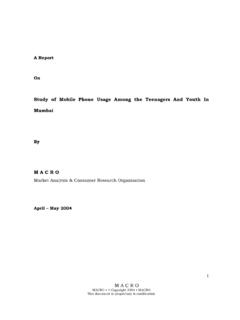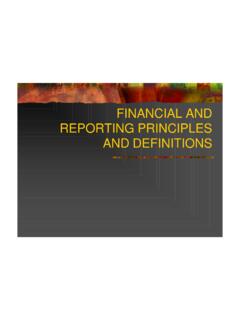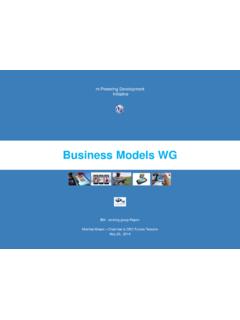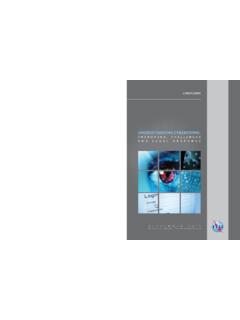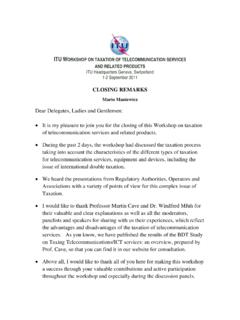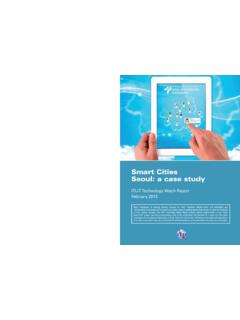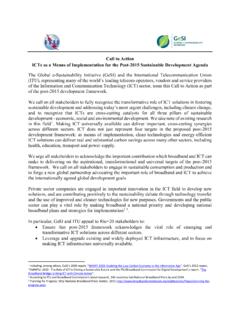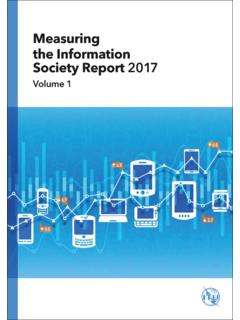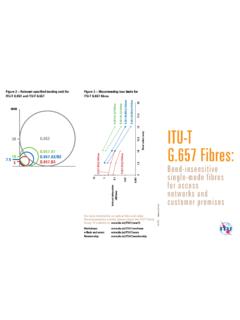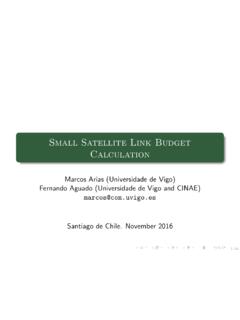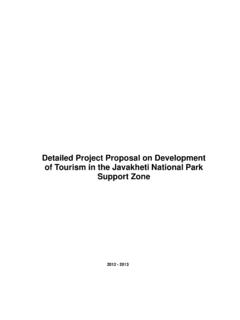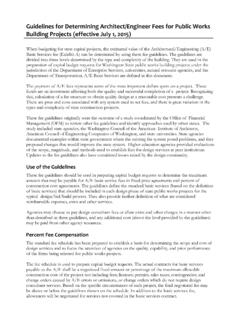Transcription of LINK BUDGET CALCULATIONS - ITU
1 link BUDGETCALCULATIONSOtto KoudelkaInstitute of Communication Networks andSatellite CommunicationsTU characteristics of TX station RX station propagation noise, interference characteristics of satelliteNOISE noise voltage independent of frequency, white noisekTBRun42 k = 10-23J/K, Boltzmann noise temperatureNOISEfS(f)NOISE at very high frequencies thermal noise vanishes, only quantum noise remains Noise powerkTBBNN 0 UPLINKEARTH -SPACERE arthGround StationSatelliteCARRIER POWER Inverse square law power ( ) power effective antenna aperture antenna gainAGRPCeffTT24 ANTENNA FORMULA effective apertureAGAeff 42 2222244 DDG 4422 GRGPCRTTCARRIER POWERGPEIRPTT RLs42free-space lossCARRIER/NOISE RATIOBTkNCNNCCs kBTGRGPNCsRTT1/42 kTGRGPNCsRTTo1/42 Signal/noiseratioSignal/noisedensityFIGU RE OF MERIT G/T [dB/K] important characteristic for satellite ground stationLINK BUDGET calculation figures may vary widely EIRP high free-space loss very high receive carrier power very low logarithmic representation advantageousLOGARITHMIC REPRESENTATION Signal-to-noise ratio [dB] )log(10)log(10)log(10)log(10/4log20)log( 10)log(10 BkTGRGPNCsRTT BkTGLEIRPdBHzKdBJKdBdBdBWNC][]/[]/[][][/ C/No carrier power / noise density Normaliset to 1 Hz noise bandwidth kTGLEIRPKdBJKdBdBsdBWoNC]/[]/[][][/ C/T sometimes used in link budgets in [dBW/K] leaves out k = dB(J/K)
2 At the end of calculation B, k considered TGLEIRPKdBdBsdBWTC/]/[][][ Eb/No energy contrast ratio energy per bit / noise density of information rate (not necessarily channel rate)rBNCNEob EXAMPLE (1) P = 10 W G = 18 dBdBmdBWEIRP582818)10log(10 Corresponds to 631 W!EXAMPLE (2) free-space loss Distance: 1000 km f = 438 MHz, = m = dBEXAMPLE (3) free-space loss, distance = 1000 km f = GHz, l = m = 160 dBEXAMPLE (4) free-space loss, distance = 1000 km f = 8 GHz, l = m = dBEXAMPLE (5) free-space loss, distance = 1000 km f = 8 GHz, l = m = dBRECEIVER G/T amplifier and antennaTantNo,ant= kTantNo,v1= Gk(Tant+ T1)No,v1,in= k(Tant+ T1)RECEIVER G/T cascaded amplifiers and antennaTantNo,v1,inNo,ant= kTantNo,v1= G1k(Tant+ T1)No,v2,in= G1k(Tant+ T1)+k T2 SYSTEM NOISE TEMPERATURE referred to input of first stageNo,v1,in= k(Tant+ T1+ T2/G1)Tsys= Tant+ T1+ T2/ G1T= (F -1)ToFriis formulaLOSSY SYSTEMS lossy lines ( coaxial cables, waveguides) L = input power / output power = 1/G Te= Tsource(L -1) if network (resistor) at To: L = F, T=(F-1).
3 290 = (L-1).290 RECEIVER WITH LOSSY LINESTantT1T2G1G2 LGTLTLTTTL antsys121 EXAMPLE A Tant= 150 K T1= 200 K G1= 25 dB F2= 8 dB G2= 40 dB L = 1 dBRESULT AGTLTLTTTL antsys121 KLFTL75290)1(290)1(290)1(10101 )1(290)1(1010822 TsysKTsys483 EXAMPLE BTantT1T2G1G2 LGTLGTTTTL antsys1211 RESULT TsysKTsys356 EXAMPLE CTantT1T2G1G2 LGTLGTTTTL antsys2122 RESULT TsysKTsys1670 RESULT TsysKTsys1670 CONCLUSION Avoidlossesin front ofLNA UseLNA withlowestpossibleNF UseLNA withhighestpossiblegainSATELLITE ANTENNA NOISE TEMP. Noise from earth Noise captured from outer space Oceans radiate more noise than land masses Conservative figure: 290 KG/T (spacecraft) Satellite antenna gain: 0 dB Tsys = 483 K (from example A) G/T = 0 10log(483) = dB/K C/N f = 438 MHz GT= 18 dB P = 10 W = 10 dBW R = 1000 km G/T = dB/K B = 200 kHz = 10log(200000) = 53 dBHz BkTGLEIRPdBHzKdBJKdBdBsdBWNC][]/[]/[][][ / ) ( C/No normalized to 1 Hz noise ) ( ADDITIONAL LOSSESPOLARIZATION LOSS If polarization plane of TX antenna and RX antenna are misaligned Lpol If TX and RX are circular.
4 No lossPOINTING LOSS antennas not totally aligned movement of satellite pointing loss, Around dB LpuATMOSPHERIC ATTENUATION gaseous absorption in atmosphere attenuation by hydrometeors depending on rain rate, drop size, frequency LatuPROPAGATION EFFECTS Influence by troposphere region up to 15 km absorption depolarization Influence by ionosphere much less significantPRECIPITATION rain drop size important hail produces very significant attenuation wet snow dry snow less criticalPRECIPITATION Occurrence of precipitation defined by percentage of time during which a given intensity is exceeded Rain rate in mm/h Different climatic zones Measurements necessary for each zoneEUROPEAFRICAKQAMERICASKNPABCCUMULATI VE >Lat% of timeCLEAR SKY ATTENUATION Depends on frequency elevation angle atmosphere pressure temperature water vapour contentIONOSPHERIC LOSSES Interaction between charged particles and electromagnetic wave Absorption, Faraday rotation, szintillation At microwave frequencies negligible Small effect at VHF/UHFC/N at SATELLITE BkTGLLLLLEIRPNC atupolipusu /EXAMPLE f = 438 MHz GT= 18 dB P = 10W = 10 dBW R = 1,000,000 m G/T = dB/K Lpol= dB Li= dB Lpu= dB Latu= 2 dB B = 200 kHzRESULT BkTGLLLLLEIRPNC atuipolpusu P = 1 P = 10 WDOWNLINKSPACE -EARTHRE arthGround StationSatelliteSATELLITE EIRP Maximum EIRP satellite: specified EIRPsat EIRP due to drive level:EIRP= EIRPsat Bout Example: EIRPsat= -3 dBW ( W into 0 dBi antenna)EIRP= = -3 1 = -4 dBWEARTH STATION ANTENNA noise from sky noise from earth above 2 GHz: dominant contribution from non-ionized region of atmosphere depends on elevation angleANTENNA NOISET foxygenwatervapourSKY NOISE TEMPERATURET elevation angle4 GHzAVAILABILITY Percentage of time in which defined QoS is met bit error rate of 10-6for % Outage.
5 Percentage of time in which attenuation is too high to meet QoS % = hours /year % = 53 minutes /yearAVAILABILITY directly related to precipitation time statisticsCLEAR SKY ATTENUATIONOXYGENWATERVAPOURABSORPTIONLf at zenithPROPAGATION MEASUEREMENTS Beacon receivers Radiometers Radar Rain gaugeINCREASE IN NOISE TEMPERATURE Atmosphere: lossy line medium temperature, 280 K to be added to overall noise temperatureTLTmatat)11( ATMOSPHERIC ATTENUATION specific attenuation a in [dB/km] path length in rateRabp alLata OVERALL NOISE TEMPERATURE Precipitation:LTTLTTatdLNBmatdantsys.)11 ( EXAMPLE Latd= 2 dB = 10 Tatm= (1 -1 ) 280 = KVARIATIONS can reach up to 1 dB/s at Ka-band slower at Ku-band any fade countermeasure technique must be able to cope with fluctuationsOTHER EFFECTSDEPOLARIZATION xyraindropletSCATTERING on rain cell no interference in clear skySCATTERING in precipitationcondition: attenuation scattering interferenceSCINTILLATIONS Variation of refraction index of atmosphere (troposphere and atmosphere) Refraction index of troposphere decreases with altitude independent of frequencyFARADAY ROTATION Ionosphere introduces a rotation of linearly polarized wave inversely proportional to frequency function of electronic content varies with time planes rotate in same direction for up -and downlink no compensation by rotating feed!
6 IONOSPHERIC EFFECTS can be neglected for normal satcom systems if exactpropagation delay matters (GPS) ionospheric model and effects must be taken into accountC/N for DOWNLINK BkTGLLLLLEIRPNC iatdepdsdpolsatd /)log(10)/(TGTGsysRe EXAMPLE EIRP = -4 dBW Polarisation loss: dB Pointing loss: dB Ionospheric losses: dB LNB noise temperature: 120 K Input loss: 1 dB Atmospheric attenuation: 2 dBG/T Earth Station calculate system noise temperatureTLTTLNALRX *) (280)1011( ) (1018/ KTRX226120* Gain of Parabolic DishC/N DOWNLINK BkTGLLLLLEIRPNC iatdepdsdpolsatd / , OVERALL C/No Composed of uplink and downlink NCNCNCdu111 NCNCNCdu111 EXAMPLE Overall C/N )10101log(10)10 ()10 ( INTERFERENCE Co-channel interference Adjacent channel interference ICNCNCNCdu1111 Eb/No Bandwidth = 200 kHz, Uncoded, user data rate= 200 kbit/s Eb/No= C/N*B/r Eb/No= dB Coded, code rate = B/r = = 2 = 3 dB Eb/No = dBBERSYSTEM MARGIN Min Eb/No= 7 dB (BER = 10-6, 1 dB implementation loss) Margin = Eb/No -Eb/Nomin Margin = 7 = dB

